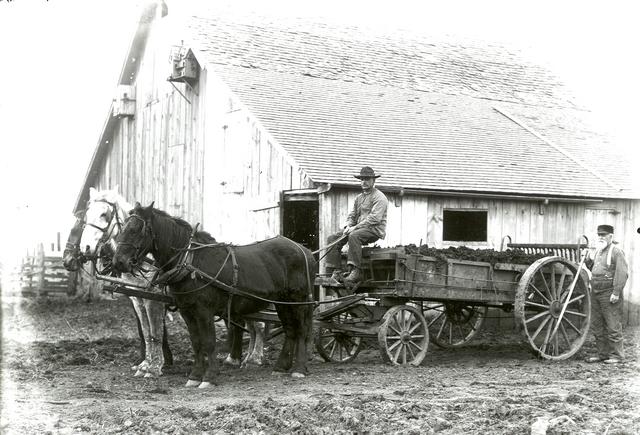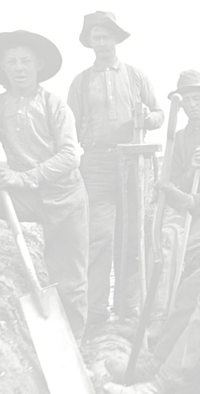Modern Farming Tools:
The Wagon Manure-Spreader

Photograph by Frank Sadorus, circa 1910
Illinois State Museum Collection
Gift of Raymond Bial
Animal manure was a very important product for sustainable farming through the late nineteenth and early twentieth century in Illinois. Chemicals were just beginning to be made and sold, and they were expensive and had to be shipped in. Meanwhile, right on the farm was a constant source of fertilizer — manure.
This photograph from the Museum's Sadorus Collection was taken around 1910 in eastern Illinois. It shows the manure wagon full and ready to go to the fields where it spread the manure with a mechanism located at the back of the wagon bed.
Under the bottom of the wagon box, there is an apron that feeds the manure to the back of the wagon bed, where a toothed drum or beater breaks up the clods and drops the manure evenly on the ground as the horses pull the wagon forward.
The Importance of Manure:
The Sustainable Farming Movement
In the early 1800s, some farmers and reformers were alarmed at the ruin of farmland in the eastern United States. They performed experiments on their own land and advocated through newspapers and journals the use of manure to refurbish soil. If soil were kept in good condition, it would continue to produce high yields. Farmers would not feel they had to emigrate to the West if their land was not in ruins.
However, there was resistance to these reforms because it meant farmers would have to store, haul, and spread manure yearly, which was expensive and difficult work. Many farmers did not want to change their methods. Some did not believe that the results would be worth the work. Some writers noted that this group considered it less work to pull up stakes and move half-way across the country than to change farming methods. The resistance was often cultural; farmers wanted to continue their old ways of farming. The reformers did not stem the tide of migration.
In the 1840s, another effort at fertilization was made with the use of guano (nitrogen-rich bird droppings mined from tropical islands). Guano companies mined the guano, shipped it to New York and Pennsylvania, and sold it for $35 per ton. Consumption by American farmers by 1855 was 140,000 tons.
Unlike manure, guano could give soil a kick to produce, but long-term health of the soil still depended on manure, both crop and animal manure. Guano also had to be imported and delivered, rather than produced on the farm. To some, this had a certain cache of progressiveness. Guano also covered more acreage per load than manure. It was a sign of the future - the use of fertilizer, pesticides, and herbicides made from chemicals.
from Larding the Lean Earth, p. 188 - 191.
Another proponent of sustainable farming was William Cobbett. Cobbett lived in England and visited the United States in the early 1820s. He had read Birkbeck's newspaper columns of letters full of glowing reports of huge grain yields with little work on the prairie. He criticized Birkbeck and his like for urging people to move to the prairie when land could be sustained in England and the eastern United States if best practices were used. He also read and reprinted a journal by countryman Thomas Hulme, who had visited Birkbeck's settlement of Wanborough in 1819, and found it nothing like the description in the letters - few fields of wheat and corn, only a house garden.
Cobbett believed in manuring, both with animal manure and with pasture crops
such as timothy and turnips. He was a proponent of the idea that by rotating
certain crops instead of letting fields lie fallow would rejuvenate the land.
The pasture and turnips could be fed to livestock, so the need for large crops
of grain would decrease. This method is being revived today in 'experimental'
farms in Illinois, to study both the costs for livestock feed and the value
to the land of pasturage.
(see attached images of Cobbett's book excerpts and S J-R's article on "Grazing,"
Nov. 13, 2003.)






